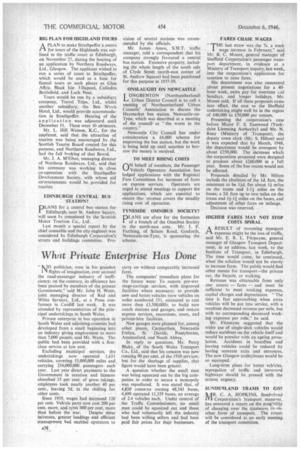What Private
Page 40

If you've noticed an error in this article please click here to report it so we can fix it.
Enterprise Has Done
" N°politician, even in his grandest flights of imagination, ever accused the road-passenger industry of inefficiency; on the contrary, its efficiency has been praised by members of the present Government," said Mr. John H. Watts, joint managing director of Red and White Services, Ltd., at a Press conference in Cardiff last week. It was attended by representatives of the principal undertakings in South Wales.
Private enterprise in bus operation in South Wales and adjoining counties had developed from a small beginning into an industry giving employment to more than 7,000 people, said Mr. Watts. The public had been provided with a firstclass service at low cost.
Excluding municipal services, the undertakings now operated 1,631 vehicles, covering 53,000,000 miles and carrying 254,000,000 passengers each year. Last year direct payments to the Government in taxation and licences absorbed 35 per cent, of gross takings, employees took nearly another 40 per cent., leaving 3d. in the shilling for other costs.
Since 1939, wages had increased 120 per cent. Vehicle parts now cost 200 per cent. more, and tyres 300r per cent, more than before the war. Despite these increases, greater loadings and efficient management had enabled operators to aag carry on without comparably increased fares.
The companies' immediate plans for the future were: To restore pre-war stage-carriage services, with improved facilities where necessary; to provide new and better vehicles (new vehicles on order numbered 531, estimated to cost more than £1,500,000); to build new coach stations and garages, and restore express services, excursions, tours, and private-hire facilities.
New garages were planned for, among other places, Carmarthen, Newcastle Emlyn, St. Davids, Pontyberem, Ammanford, and Neath Abbey.
In reply to questions, Mr. Percy Blake, of the South Wales Transport Co., Ltd., said that his concern was now running 90 per cent, of the 1939 services; but for the shortage of supplies, that figure would have been greater.
A question whether the small man was being squeezed out by the big companies in order to secure a monopoly was repudiated. It was stated that, of 4,850 concerns owning 48,543 buses, 4,699 operated 11,359 buses, an average of 2.4 vehicles each. Under control of the Traffic Commissioners, no small man could be squeezed out and those who had voluntarily left the industry had been willing sellers and had been paid fair prices for their businesses.




































































